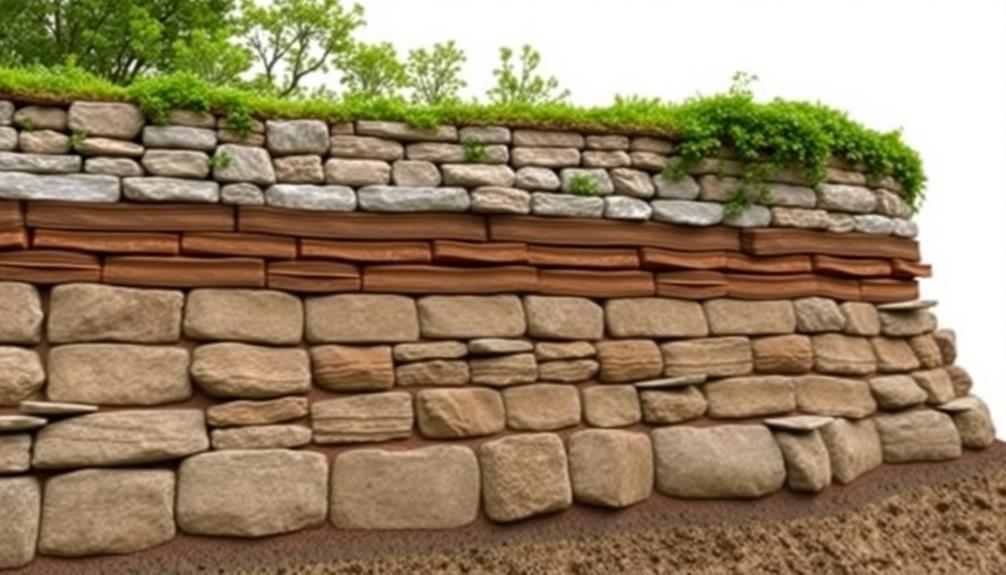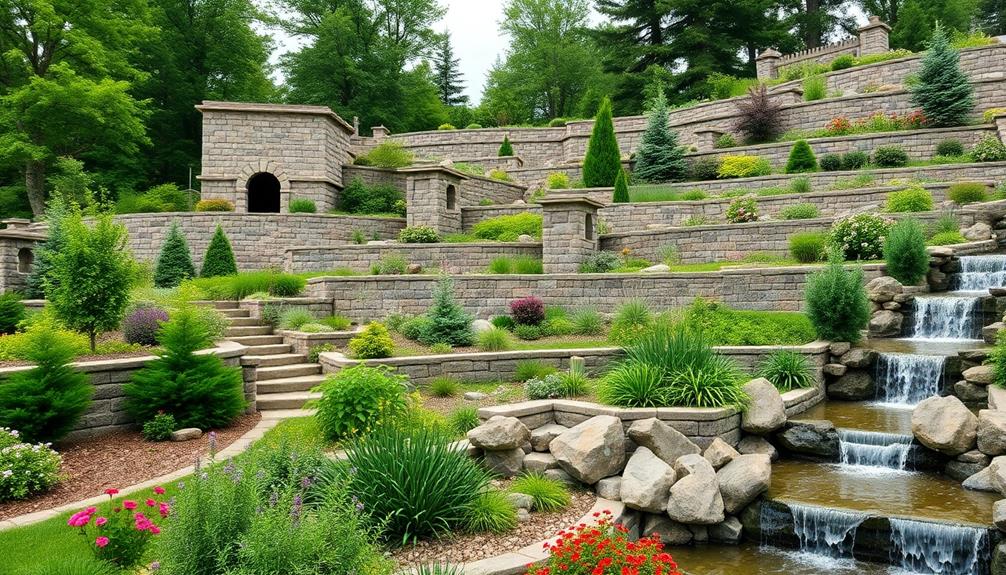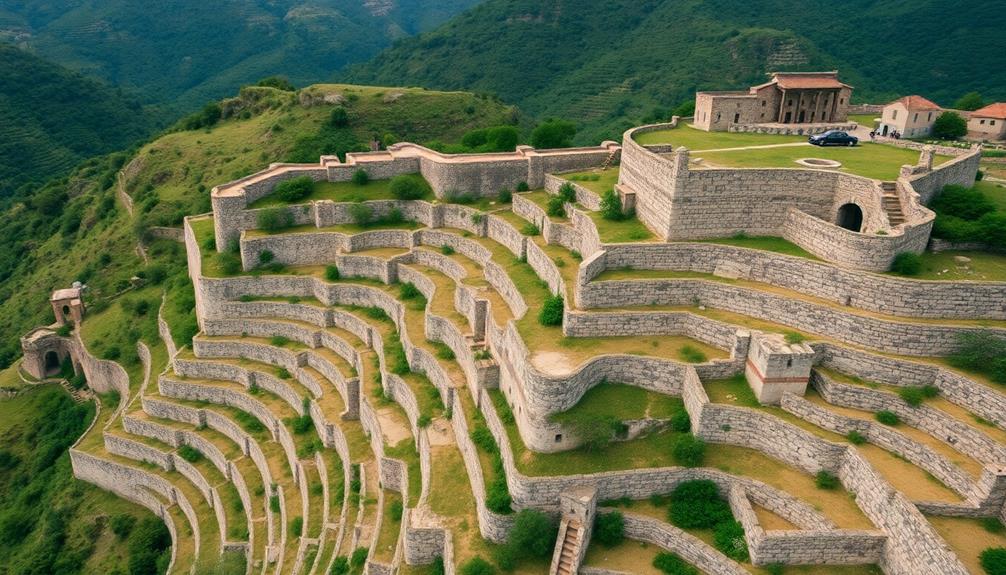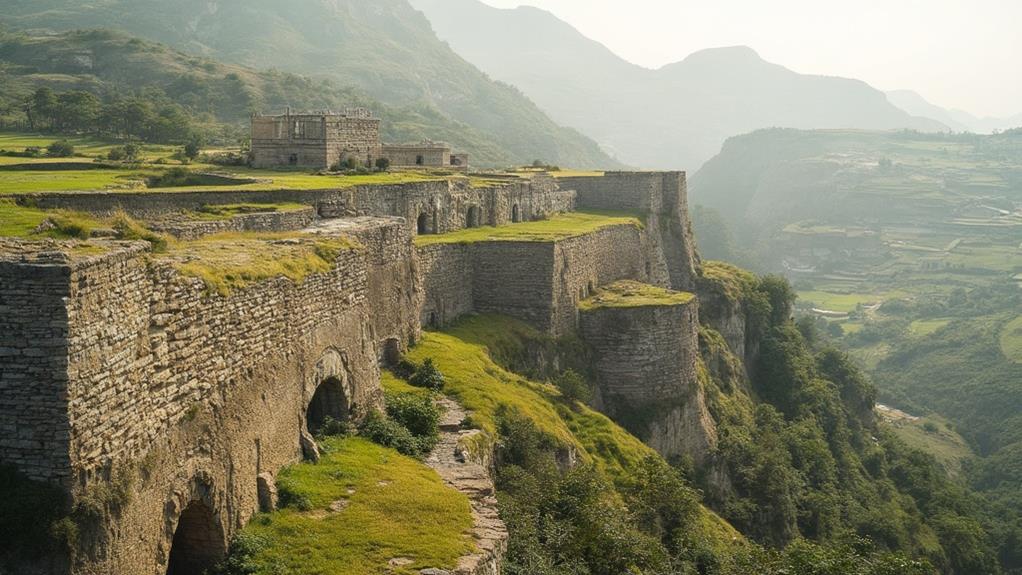Retaining walls have a storied history, beginning with ancient civilizations like the Mesopotamians, Egyptians, Greeks, and Romans who ingeniously employed stone masonry, gravity, and stability principles to counteract soil forces. These early engineers used locally sourced materials, expertly arranged, demonstrating a synergy between stone and brick for durable construction. Various methods such as terracing and buttressing were developed to enhance agricultural and structural stability, reflecting the cultural significance of these structures. Over time, advancements in materials and design, including reinforced concrete and innovative wall types, have furthered their utility in flood prevention, increased land usability, and aesthetic landscaping. This rich heritage informs current engineering methods in fascinating ways.
Table of Contents
ToggleWalls Contractor Highlights
- Ancient civilizations built retaining walls using stone, brick, and gravity principles prioritizing stability and weight distribution.
- Diverse methodologies, such as stone masonry, terracing, and hydraulic techniques, were developed to enhance structural integrity and soil retention.
- Gravity, cantilevered, segmental, and anchored walls represent adaptive techniques catering to varied site conditions and engineering requirements.
- Technological advancements introduced reinforced concrete and geosynthetics, enhancing wall strength, flexibility, and resilience.
- Retaining walls prevent erosion, manage water flow, and transform terrains into usable spaces, contributing to both safety and aesthetic enhancement.
Retaining Wall Defined

Retaining walls serve an indispensable purpose in landscape and construction management by preventing soil erosion and managing land elevation differences, often fulfilling both aesthetic and practical requirements. These structures come in various types, including gravity, cantilevered, sheet piling, and anchored walls, each designed to suit specific site conditions and engineering demands.
Companies like Boulder Walls leverage their expertise and a variety of materials such as limestone, boulders, and granite to construct these walls, focusing on both structural integrity and weatherproofing. A thorough understanding of their structural considerations, such as load-bearing capacity and resistance to environmental forces, is essential to guarantee the stability and longevity of the retaining wall.
Purpose and Functionality
A necessary element in landscape and structural design, a retaining wall serves the primary purpose of holding or retaining soil behind it. This function is indispensable for preventing soil erosion, managing water runoff, and stabilizing slopes across a variety of environments. Retaining walls transform hilly or uneven terrain into usable, flat surfaces, often enabling the creation of gardens, pathways, roads, and other imperative infrastructures. By incorporating these features, communities find ways to harmoniously coexist with nature, promoting a sense of belonging and environmental stewardship.
Moreover, retaining walls can markedly influence the aesthetic and economic aspects of a property. They provide structural support while enhancing the landscape's beauty, creating inviting spaces in residential, commercial, and public projects. Functionality extends to their ability to manage water flow and reduce landslide risks, which are indispensable for cohesive community development. Through securing slopes and managing earth movements, retaining walls contribute not only to individual property value but also to the collective safety and wellbeing of a neighborhood.
Understanding the purpose and functionality of retaining walls emphasizes their fundamental role in constructing environments where human ambition and nature can flourish together, fostering stronger bonds within a community.
Types of Retaining Walls
Diversity in design reflects the adaptability and innovation found in the various types of retaining walls, each serving distinct structural and aesthetic purposes. Among the most familiar are gravity walls, constructed to leverage their mass to resist lateral earth pressure. These walls are often composed of concrete, stone, or even uncemented materials, adhering seamlessly to diverse landscapes.
Cantilevered walls present a more engineered solution by incorporating reinforced concrete, forming an L-shape where stability is achieved through the wall's weight and an extended footing. This design optimizes material usage while efficiently addressing load distribution.
Segmental retaining walls, characterized by their modular construction approach, demonstrate flexibility and ease of installation, appealing to a community inclusive of DIY enthusiasts and professional constructors alike. Utilizing blocks that interlock, these walls accommodate a variety of terrain features and can maintain aesthetic cohesion across projects.
Lastly, anchored walls present solutions for slender profiles in constrained spaces. Using cables or tiebacks anchored into the soil, these walls are bolstered against earth pressures yet maintain a minimalistic form that caters to modern design sensibilities. Each type exemplifies the blending of form and function, ensuring that differing project demands are met with precision and innovation.
Structural Considerations
When examining the foundational elements of retaining walls, structural considerations take precedence as they guarantee the integrity and longevity of these essential constructs. The purpose of a retaining wall is to support and stabilize earth, especially on sloped terrains, necessitating careful attention to several significant factors in its construction. Understanding these considerations fosters a sense of assurance and unity for those involved in creating durable landscapes.
Among the primary concerns is the wall's ability to resist lateral earth pressures that arise due to soil weight and water accumulation. To achieve this, engineering principles dictate specific design elements—such as the wall dimensions, materials used, and types of reinforcements like geogrids or anchors. The selection of appropriate materials—ranging from concrete and stone to treated wood—directly influences the wall's load-bearing capacity and its environmental adaptability.
Equally pivotal is the drainage strategy, as improper water management can compromise the wall's stability. Incorporating weep holes, drainage pipes, or backfill materials with good permeability is essential to avert hydrostatic pressure. By meticulously addressing these structural factors, communities can achieve sustainable, cohesive environments that combine functionality with aesthetic integration, enhancing collective living spaces.
Benefits

The evolution of retaining walls has ushered in numerous benefits that are essential to modern infrastructure and landscape design. Fundamentally, they provide enhanced structural integrity to slopes and embankments, considerably mitigating risks associated with erosion and flooding.
Various materials, such as limestone, are used to enhance both durability and aesthetic appeal, with limestone walls adding a natural and elegant look to yards and homes. Additionally, retaining walls create increased usable space in challenging terrains while contributing to aesthetic landscape enhancement through their varied designs and materials, thereby transforming challenging topographies into functional and visually appealing environments.
Enhanced Structural Integrity
How has the development of retaining walls evolved to enhance structural integrity? Historically, retaining walls were primarily constructed using rudimentary techniques and materials that limited their load-bearing capabilities. Over time, advancements in engineering and materials science have significantly improved their structural integrity, enabling them to support substantial stresses and adapt to varied geological conditions.
The introduction of reinforced concrete and geosynthetic materials allowed modern retaining walls to exhibit increased strength and flexibility. These materials offer greater resistance to forces such as earth pressure, thermal expansion, and settlement, effectively prolonging the lifespan of the structures.
Innovative design approaches, such as segmented retaining walls and mechanically stabilized earth systems, further enhance structural reliability. Segmented walls, constructed using interlocking units, provide stability through both weight and frictional resistance. In mechanically stabilized earth systems, layers of backfill material are reinforced with polymeric strips or grids, which optimize load distribution and reduce the prospects of structural failure.
These advancements, coupled with extensive geotechnical analysis and design software, empower engineers to tailor retainment solutions to specific site conditions and environmental demands. The collaborative efforts of industry professionals and community stakeholders have been essential, reinforcing robust frameworks that accommodate the safety, durability, and sustainability expectations of modern societies.
Erosion and Flood Prevention
Effective erosion and flood prevention is critical to safeguarding landscapes and infrastructures. Retaining walls, as an essential element of civil engineering, prevent soil displacement and manage water flow, protecting various communal and natural environments from adverse weather-induced changes. These structures are pivotal in preserving the integrity of landscapes, deflecting the impacts of rainfall and groundwater that might otherwise erode the earth beneath roads, buildings, and personal property. Retaining walls serve not only as physical barriers but also foster a sense of community security by preserving natural and built environments.
Retaining walls offer significant benefits in erosion and flood prevention:
- Soil Stability: They hold back soil on sloped terrains, reducing the risk of landslides.
- Water Runoff Control: By redirecting water flow, they mitigate the impact of floods.
- Property Protection: They preserve the landscape aesthetics and functionality, maintaining property values.
- Biodiversity Preservation: Protecting natural habitats from severe erosion ensures ecological stability.
- Community Infrastructure Safety: Roads and highways benefit from these structures, enhancing accessibility and safety.
Communities benefit profoundly from retaining walls, recognizing their dual role in support and protection. By integrating such resilient designs, towns and cities can effectively address natural threats, fostering environments where families and businesses thrive.
Increased Usable Space
Constructing retaining walls not only prevents erosion but also creates increased usable space in otherwise challenging landscapes. This creates opportunities for communities seeking to maximize the utility of their geographical environment.
By transforming sloped and uneven terrains into flat surfaces, retaining walls become instrumental in cultivating spaces that support infrastructure, agriculture, and recreational activities, enhancing the overall quality of life.
Communities historically have turned to retaining walls to reclaim land, enabling agricultural cultivations on terraced hillsides. This, in turn, fostered a sense of belonging and prosperity by allowing members to sustain themselves in regions that might have otherwise been inhospitable.
In urban environments, these structures have been pivotal in maximizing land use, permitting the construction of roads, buildings, and public spaces where natural topography might pose significant constraints.
Beyond infrastructure, the increased usability of land has significant implications for recreational and communal spaces. Parks, walkways, and gardens can be established on newly stabilized ground, promoting community interaction and offering a shared environment for leisure and cultural expression.
Thus, the thoughtful incorporation of retaining walls into landscapes facilitates a harmonious balance between humans and nature, nurturing a sense of place and social cohesion.
Aesthetic Landscape Enhancement
Retaining walls, beyond their functional contributions to land use, also serve as pivotal elements in enhancing the aesthetic appeal of landscapes. They interplay harmoniously with natural and built environments, providing an approachable surface upon which greenery can thrive, while also serving as a visual divide between different areas of a garden or yard.
Not only do they prevent erosion and manage runoff, but they also craft an architectural narrative echoing the homeowner's style and aspirations.
Key benefits of retaining walls in aesthetic enhancement include:
- Versatility in Materials: Retaining walls can be constructed from diverse materials, including stone, brick, and timber, each lending a unique texture and color palette.
- Customization Options: With various heights, shapes, and finishes, these walls can be tailored to match personal design preferences and landscape features.
- Textural Interest: Sculptural lines and textured surfaces create visual interest and dynamics in an otherwise flat terrain.
- Integration of Nature: Strategic placement can create terraces for plantings, seamlessly integrating flora with structural design.
- Projecting Elegance: They embody artistic craftsmanship, projecting elegance and sophistication that blend functionality with beauty.
Thus, retaining walls form a fundamental architecture of landscape aesthetics, fostering a sense of belonging and coherence within outdoor spaces.
Ancient City Engineering Techniques

Ancient civilizations engineered impressive retaining walls using stone and brick methods that prioritized gravity and stability principles, foundational to supporting their growing urban landscapes. These early societies—ranging from the Mesopotamians to the Romans—demonstrated remarkable ingenuity in constructing long-lasting structures that addressed both environmental challenges and aesthetic ambitions. To appreciate these contributions, consider the following historical examples:
| Civilization | Technique | Notable Structure |
|---|---|---|
| Mesopotamian | Stone Masonry | City Walls of Babylon |
| Egyptian | Mud-brick | Fortifications of Buhen |
| Greek | Ashlar Masonry | Defensive Walls of Mycenae |
| Roman | Concrete Use | Aurelian Walls of Rome |
These instances highlight each civilization's unique approach, showcasing their enduring legacy in engineering.
Stone and Brick Methods
Incorporating stone and brick into retaining wall structures has been a cornerstone of ancient city engineering techniques, exemplifying both the architectural ingenuity and practical necessities of early civilizations. These materials were favored not only for their aesthetic value but also for their robustness in construction.
Stone, with its natural strength and availability, was often combined with brick, which allowed for more versatile shaping and ease of production. This synergy between materials enabled the creation of formidable structures that have withstood the test of time, allowing modern societies to learn from past triumphs.
In understanding the utilization of stone and brick, several key aspects are remarkable:
- Durability: These materials were chosen for their longevity and resistance to the elements, ensuring a lasting foundation.
- Adaptability: Both stone and brick could be tailored to different topographies, making them ideal for varied landscapes.
- Aesthetic Appeal: The harmonious blend of natural stone with fashioned brick lent an aesthetically pleasing aspect to city walls.
- Resource Efficiency: The abundance of these materials in many regions made them sustainable choices for large-scale construction.
- Cultural Significance: Retaining walls constructed with these materials often held cultural and symbolic importance within ancient societies.
This historical reliance on stone and brick serves as a record to the shared human quest for stability and resilience.
Gravity and Stability Principles
Key to the enduring success of ancient retaining wall structures was the understanding and application of gravity and stability principles. Skilled ancient engineers mastered leveraging the weight of the retaining wall itself to counteract the lateral earth pressure attempting to displace it. By adhering to fundamental principles of gravity and stability, builders guaranteed that these structures were both functional and durable, utilizing mass and weight distribution effectively to maintain equilibrium.
Incorporating a sloped or battered design, the walls were crafted to lean slightly against the earth they were meant to retain, enhancing their stability. This tactic increased friction and sheer weight against the undermining forces of the soil, preventing collapse. Additionally, these walls often utilized a base that was wider than their crest, enhancing foundational stability by lowering the center of gravity closer to the ground.
The success of these techniques resonated throughout communities, uniting individuals in the shared belief in their engineering prowess. As members of these ancient societies, people found comfort in the durability and reliability of these structures, as they represented human ingenuity and the power of collective knowledge. Such principles continue to inform and inspire modern engineering practices worldwide.
Ancient Civilizations' Contributions
Harnessing the remarkable engineering techniques of ancient civilizations has had a profound impact on the evolution of urban landscapes. These early builders laid the groundwork for modern retaining wall construction, employing ingenious methods that have endured through the ages.
Ancient cities like Babylon, Rome, and Machu Picchu integrated retaining structures not just for their utility, but as a statement of their architectural prowess and cultural ideologies. Their diverse methodologies underline a shared human endeavor to manipulate natural landscapes into more habitable environments.
- Stone Masonry: Utilizing locally sourced materials, stones were meticulously cut and arranged, ensuring stability and resilience against time and elements.
- Terracing Techniques: By creating stepped terraces, cities could expand arable land and manage erosion, promoting sustainable agriculture.
- Buttressing Methods: Walls were supported by external projections, reinforcing their strength and ensuring their long-term durability.
- Crib Walls: Utilized wooden or stone frames filled with earth to form an early and effective form of soil retention.
- Hydraulic Engineering: By incorporating irrigation and drainage systems, these civilizations enhanced soil stability and prevented water-related erosion.
These ancient innovations evoke a sense of belonging and continuity, reflecting a collective ambition to harmonize living spaces with nature's constraints.
Walls Contractor FAQ
How Did Climate Influence Historical Retaining Wall Designs?
Climate substantially shaped retaining wall designs by dictating material selection, construction techniques, and drainage solutions. Regions experiencing heavy rainfall or freeze-thaw conditions prioritized durable materials and advanced engineering to guarantee structural stability and longevity, fostering community resilience and safety.
What Materials Were Predominantly Used in Early Retaining Wall Constructions?
In early retaining wall constructions, materials such as stone, timber, and natural earth were chiefly used. These materials were chosen for their local availability and inherent strength, fostering a sense of connection and harmony with the environment.
How Did Technological Advances Affect Retaining Wall Engineering Over the Centuries?
Technological advancements greatly enhanced retaining wall engineering by introducing innovative materials and construction techniques, improving structural integrity, flexibility, and sustainability. These developments fostered a sense of belonging within communities by ensuring safer, more durable infrastructures.
What Challenges Did Ancient Engineers Face When Building Retaining Walls?
Ancient engineers faced challenges such as material limitations, geological unpredictability, and lack of advanced tools. Overcoming these obstacles required ingenuity and collaboration, fostering a sense of community and shared purpose essential to successful retaining wall construction.
How Have Historical Retaining Walls Inspired Modern Design Practices?
Historical retaining walls inspire modern design through their demonstrated ingenuity in materials and construction techniques. These ancient solutions inform today's engineers, fostering a sense of continuity, community, and collective advancement in creating durable, aesthetically pleasing infrastructure for the future.







